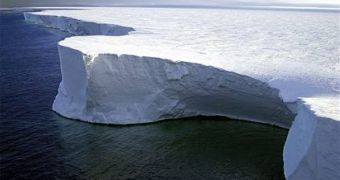In small amounts, ice is just a solid, brittle, crystalline material; but when an ice layer surpasses 60-100 m (200-330 ft), the under part behaves like a plastic material, engaged in a slow flow so that the whole ice mass spreads over an extended area or displaces on a slope.
For a glacier to appear, the snowfall from the past winter must overcome the melting or evaporation (the so-called ablation). By the melting and re-freezing of the upper layer, the snow is turned in granulated ice, which can experience hardening under the pressure of the upper layers, and is turned to crystalline compact ice. Through this process, in thousands of years huge glaciers can form.
11 % of the land surface is covered by glaciers (23 million square km).
14.1 million are in Antarctica, 21,000 square km in mountain glaciers in southern temperate zone, 100 square kilometers in tropical mountain glaciers, 100,111 square km in mountain glaciers in northern temperate zone and 2.2 million square km in the Arctic (1.65 in Greenland alone, the rest in the Canadian Arctic archipelago and other Arctic archipelagos: Novaia Zemlea 22,600 square km, Svalbard 30,800 square km, Severnaia Zemlea 15,600 square km).
97 % of the current ice surface and 99.75 % of its volume are located in Antarctica and Greenland. (90 % in Antarctica, with 29.46 million cubic km of ice: this is 66 % of the fresh water amount on Earth!).
Another 7 million square km of the ocean are covered by ice. 75 % of the world's fresh water reserves are located in ice; the total ice melting would raise the sea levels by 60 m (200 ft). During the Ice Age, they covered 38 % of the land surface and in North America reached the latitude of 40? N and the Alps were covered by a single huge ice cap, whose remains are the current small glaciers of the Alps.
The ice pack of the Antarctica covers a surface greater than Europe's and is 5,000 m (16,670 ft) thick in some places (but 2,200 m or 7,300 ft on average), while the Greenland ice pack can be till 3,400 m (11,300 ft) thick.
In the 80's, the thickness of the Antarctic ice shelf was already decreasing by 8.3 cm (3.3 inch) annually.
The continental ice covering the ground at the sea level or at low altitude is called ice sheet. When the ice layer floats on the sea, it's called ice pack (ice packs are the main source for icebergs). In the temperate and tropical areas, the mountain glaciers emerge between 3,000 and 8,000 m (10,000-26,667 ft).
When the initial ice of the glacier collects in a depression, these are called cirque glaciers. Cirque glaciers are usually narrow and long, as they occupy pre-existent valleys. While moving towards lower altitudes, where temperatures are higher, the glaciers experience ablation and the ice is lost. Mountain glaciers never can be so thick as the ice packs, because the slope makes them slip downward.
In some cases, the mountain glaciers can have the aspect of small ice sheets, being called plateau glaciers, like in Pamir Mountains, New Zealand mountains, or Swiss Alps). Valley glaciers are found in very steep slopes. Valley glaciers can be of the Alpine type, with an accumulation zone of firn (smoothed snow). They flow downwards depending on the latitude and on the relief.
The Himalayan type glaciers are larger than those from the Alps and branched, like Fedcenko Glacier (Pamir, Tajikistan) which is 71 km (45mi) long and with a surface of 907 square km or Inylchek from Tian Shan Mountains, which is 60 km (47 mi) long with a surface of 255 square km.
A Kilimanjaro type is that which is found in the craters of the volcanic cones, presenting radial languages. The Scandinavian is represented by ice mattresses on higher plateaus that slowly flow to the bottom of the fjords.
At high altitudes, due to the low air pressure, the ice can be viscous, favoring a downward slip of tens of meters annually. Sometimes, mountain glaciers can experience sudden episodes when the went downward up to 60 m (200 ft), wiping out everything on their way. Piles of debris (stones and soil) moved by glaciers are called moraines.
Today, mountain glaciers are melting fast, and in tropical areas they retreat with 30 % each century, in temperate areas with 1-15 %. At the beginning of the XX century, there were 239 glaciers in the Italian Alps, and in 1950 there were just 163! In Greenland, the retreat is of 3-6 % and in Antarctica 0.5-3 %.
These numbers would mean that the Alps' glaciers would disappear in 300 years and those in Greenland in about 1,600 years. Recent measurements revealed instead that, at the current melting rate, this could occur in fact in less than 100 years.

 14 DAY TRIAL //
14 DAY TRIAL //